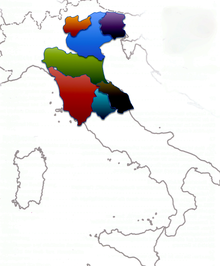Third Italy
The north-eastern and central Italian industrial districts of the country are referred to as the Third Italy (Italian Terza Italia ) . These are areas that have developed industrially, particularly since the 1970s. These include the regions of Tuscany , Emilia-Romagna and Veneto (core regions), as well as Umbria , Marche , Trentino-South Tyrol and Friuli-Venezia Giulia . These areas are characterized by a "production network of small and medium-sized companies with a high degree of specialization and close, predominantly vertical production links".
The term “Third Italy” is used to distinguish it from the long-established industrialized regions, especially in north-western Italy ( triangolo industriale ) and the less industrialized southern Italy, the so-called “ Mezzogiorno ”. The economic structure in Italy is commonly divided into three higher-level industrial regions, the western Po plain with its traditionally strongly networked and urbanized structures stands out as the leading region. Since the 1970s, however, the north-east and center of Italy have also been summarized in regional science under the technical term "Third Italy" and thus describes the Italian industrial districts that accumulated in this area. The south of Italy has the greatest pent-up demand. Despite the Cassa per il Mezzogiorno, a special subsidy policy for the construction of the South (discontinued in 1992), the area belongs to the Objective 1 regions of the EU and is therefore one of the recipient regions of the Union.
Conceptual and research history
General
The term Terza Italia was coined in 1977 by the sociologist Arnaldo Bagnasco . His investigation of the development of companies, employees and company sizes made it clear that a special industrial structure has developed in the regions of Third Italy. The number of companies and employees in the north-west fell continuously, while the regions of the Third Italy produced significant growth rates. Last but not least, the decline in employment in the north-west was linked to the relocation of functions to the south, but the number of employees in the regions of the Third Italy increased while the size of the company fell at the same time. According to Harald Bathelt and Johannes Glückler , this phenomenon is "an expression of the high dynamism of business start-ups". These foundations are particularly pronounced in the cities of Third Italy. This trend is also being significantly boosted by the expansion of the Via Emilia transport line in the Emilia-Romagna region .
Example Tuscany - leather tanneries and textile manufacturers
Santa Croce is a small town between Pisa and Florence in the Tuscany region . The leather tanneries only produce high-quality leather for fashionable and design-intensive shoes. Before 1970, the traditional companies - following the industrialization trend - were combined into larger companies. But when the mass markets began to stagnate due to international competition, a process of reintegration began and numerous small, highly specialized tanneries and complementary suppliers and service providers were founded. This form of division of labor and specialization allowed this region to assert itself internationally and to remain competitive.
The neighboring region of Prato also succeeded in asserting itself, despite the increasing competition from low-cost countries. Here, too, they specialized in high-quality and high-quality production. The region was also able to rely on a craft tradition. Specialized dealers also emerged who sold their region's products on the international market and managed to acquire customer requirements. Through these (international) market contacts, the producers were able to accumulate market information and thus adapt to changing demand at an early stage. In the case of Santa Croce, the individual companies even organized a joint market research center.
Assessment of the phenomenon
The economic model of the Italians in the regions of Third Italy seems to be a solid and crisis-resistant form of economic activity for the time being. If you take the current balance sheet from the economic crisis of 2008/2009, Italy is antonymic compared to its southern European neighbors . The Spiegel Online editorial team states that the country has “crisis-proof banks, stable property prices”, relatively low unemployment and an adequate level of national debt. Last but not least, the Third Italy has played a decisive role in this development thanks to its traditional craftsmanship and high degree of specialization in high-quality products. While the mass-oriented producers had to lay off workers, as they did in the 1970s, the small and medium-sized enterprises were once again able to present themselves confidently. However, the increasing pressure from the low-wage countries is also causing problems for these regions, and in the recent past they themselves had to relocate work processes to more cost-effective foreign countries and import semi-finished products from these countries.
literature
- Harald Bathelt, Johannes Glückler: Economic geography. Economic relationships in a spatial perspective. UTB, Stuttgart 2003, ISBN 3-8252-8217-1 .
- Harald Bathelt: Regional growth in networked structures: conceptual overview and critical evaluation of the phenomenon 'Third Italy'. In: The Earth. 129 (1998), H. 3, pp. 247-271.
- Klaus Rother , Franz Tichy : Italy. Geography, history, economics, politics. WBG, Darmstadt 2008.
- Eike W. Schamp : Networked Production. Industrial geography from an institutional perspective. Darmstadt 2002.
Individual evidence
- ↑ Harald Bathelt, Johannes Glückler: Wirtschaftsgeographie. Economic relationships in a spatial perspective. P. 182
- ^ Arnaldo Bagnasco: Tre Italie: la problematica territoriale dello sviluppo italiano. (= Studi e ricerche vol. 74). Il mulino, Bologna 1977. ISBN 8-8150-0593-5
- ↑ Harald Bathelt, Johannes Glückler: Wirtschaftsgeographie. Economic relationships in a spatial perspective. P. 184
- ↑ Ash Amin , Nigel Thrift : Neo-Marshallian Nodes in Global Networks. In: International Journal of Urban and Regional Research. Vol. 16, H. 4, pp. 571-587. doi : 10.1111 / j.1468-2427.1992.tb00197.x
- ^ Michael J. Piore , Charles F. Sabel , The Second Industrial Divide: Possibilities For Prosperity. Basic Books, New York 1984. ISBN 0-4650-7561-4
Web links
- Third Italy. Entry in Gabler's economic dictionary.
- Leaflet Industrial Districts and Third Italy. Description of regional production systems using the example of Third Italy. Klett-Verlag, Stuttgart 2004.
